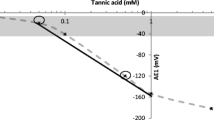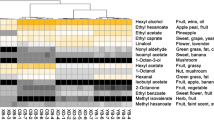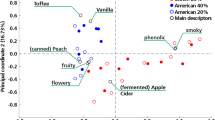Abstract
To evaluate the taste characteristics of Chinese bayberry juice, four types of bayberry juice sourced from different origins and varieties were analysed using sensory evaluation, chromatography, spectroscopy analysis and an electronic tongue (E-tongue). Nine organic acids and three sugars were assessed using high performance liquid chromatography. Total polyphenols were measured by spectrophotometry. The overall taste profile was collected using the E-tongue. The four types of bayberry juice differed in the sensory attributes of sour, sweet, bitter, and astringent. The E-tongue responses combined with discriminant analysis were able to characterise the taste profiles of the juices. The relationships between the taste compounds and the sensory panel scores established by partial least squares showed that total polyphenols, quininic acid, maleic acid, fructose, citric acid, lactic acid, succinic acid and sucrose made significant contributions to the taste characteristics of the Chinese bayberry juice.



Similar content being viewed by others
References
Arena ME, Zuleta A, Dyner L, Constenla D, Ceci L, Curvetto N (2013) Berberis buxifolia fruit growth and ripening: evolution in carbohydrate and organic acid contents. Sci Hortic 158:52–58
Bleibauma RN, Stone H, Tan T, Labreche S, Saint-Martin E, Isz S (2002) Comparison of sensory and consumer results with electronic nose and tongue sensors for apple juices. Food Qual Prefer 13:409–422
Boss PK, Davies C (2001) Molecular biology of sugars and anthocyanin accumulation in grape berries. In: Kalliopi A, Roubelakis-Angelakis KA (eds) Molecular biology and biotechnology of the grapevine. Kluwer Academic Publishers, Dordrecht, pp 1–34
Canadanovic-Brunet JM, Djilas SM, Cetkovic GS, Tumbas VT, Mandic AI, Canadanovic VM (2006) Antioxidant activities of different Teucrium Montanum L. extracts. Int J Food Sci Tech 41:667–673
Cetóa X, González-Calabuiga A, Capdevilab J, Puig-Pujolb A, del Valle M (2015) Instrumental measurement of wine sensory descriptors using avoltammetric electronic tongue. Sensor Actuators B Chem 207:1053–1059
Cheng H, Chen JL, Chen SG, Wu D, Liu DH, Ye XQ (2015) Characterization of aroma-active volatiles in three Chinese bayberry (Myrica rubra) cultivars using GC–MS–olfactometry and an electronic nose combined with principal component analysis. Food Res Int 72:8–15
Chinnici F, Spinabelli U, Riponi C, Amati A (2005) Optimization of the determination of organic acids and sugars in fruit juices by ion-exclusion liquid chromatography. J Food Compos Anal 18:121–130
Dias LG, Peres AM, Barcelos TP, Sá Morais J, Machado AASC (2011) Semi-quantitative and quantitative analysis of soft drinks using an electronic tongue. Sensor Actuators B Chem 154:111–118
Dorta E, González M, Gloria Lobo M, Sánchez-Moreno C, de Ancos B (2014) Screening of phenolic compounds in by-product extracts from mangoes (Mangifera indica L.) by HPLC-ESI-QTOF-MS and multivariate analysis for use as a food ingredient. Food Res Int 57:51–60
Harker FR, Marsh KB, Young H, Murray SH, Gunson FA, Walker SB (2002) Sensory interpretation of instrumental measurements 2: sweet and acid taste of apple fruit. Postharvest Biol Technol 24(3):241–250
Hosseinian FS, Li W, Beta T (2008) Measurement of anthocyanins and other phytochemicals in purple wheat. Food Chem 109:916–924
Kallithraka S, Bakker J, Clifford MN (1997) Evaluation of bitterness and astringency of (+)-catechin and (−)-epicatechin in red wine and in model solution. J Sens Stud 12:25–37
Kelebek H, Selli S, Canbas A, Cabaroglu T (2009) HPLC determination of organic acids, sugars, phenolic compositions and antioxidant capacity of orange juice and orange wine made from a Turkish cv. Kozan. Microchem J 92(2):187–192
Lea AGH, Arnold GM (1978) The phenolics of cider: bitterrness and astringency. J Sci Food Agric 29:478–483
Peres AM, Dias LG, Barcelos TP, Sá Morais J, Machado AASC (2009) An electronic tongue for juice level evaluation in non-alcoholic beverages. Proc Chem 1:1023–1026
Qiu SS, Wang J, Gao LP (2015) Qualification and quantisation of processed strawberry juice based on electronic nose and tongue. LWT Food Sci Technol 60:115–123
Roopa GS, Kasiviswanatham V (2013) Extraction of tartaric acid from tamarind pulp and analysis of the acid composition in leaves. Int J Stud Res Technol Manag 1(5):478–488
Stinco CM, Baroni MV, Di Paola Naranjo RD, Wunderlin DA, Heredia FJ, Melendez-Martínez AJ, Vicario IM (2015) Hydrophilic antioxidant compounds in orange juice from different fruit cultivars: composition and antioxidant activity evaluated by chemical and cellular based (Saccharomyces cerevisiae) assays. J Food Compos Anal 37:1–10
Sun CD, Huang HZ, Xu CJ, Li X, Chen KS (2013) Biological activities of extracts from chinese bayberry (Myrica rubra Sieb. et Zucc.): a review. Plant Foods Hum Nutr 68:97–106
Toldam-Andersen TB, Hansen P (1997) Growth and development in black currants (Ribesnigrum). III. Seasonal changes in sugars, organic acids, chlorophyll and anthocyanins and their possible metabolic background. J Hortic Sci 72(1):155–169
Versari A, Parpinello GP, Mattioli AU, Galassi S (2008) Characterisation of Italian commercial apricot juices by high-performance liquid chromatography analysis and multivariate analysis. Food Chem 108:334–340
Verzelloni E, Tagliazucchi D, Conte A (2007) Relationship between the antioxidant properties and the phenolic and flavonoid content in traditional balsamic vinegar. Food Chem 105:564–571
Xie LJ, Ye XQ, Liu DH, Ying YB (2009) Quantification of glucose, fructose and sucrose in bayberry juice by NIR and PLS. Food Chem 114:1135–1140
Acknowledgments
The work was funded by the Science Funds for National Excellent Doctoral Dissertation of China (No. 201059).
Author information
Authors and Affiliations
Corresponding author
Rights and permissions
About this article
Cite this article
Yu, H., Zhang, Y., Zhao, J. et al. Taste characteristics of Chinese bayberry juice characterized by sensory evaluation, chromatography analysis, and an electronic tongue. J Food Sci Technol 55, 1624–1631 (2018). https://doi.org/10.1007/s13197-018-3059-4
Revised:
Accepted:
Published:
Issue Date:
DOI: https://doi.org/10.1007/s13197-018-3059-4




